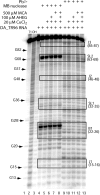A role for hydrophobicity in a Diels-Alder reaction catalyzed by pyridyl-modified RNA
- PMID: 19304744
- PMCID: PMC2685102
- DOI: 10.1093/nar/gkp177
A role for hydrophobicity in a Diels-Alder reaction catalyzed by pyridyl-modified RNA
Abstract
New classes of RNA enzymes or ribozymes have been obtained by in vitro evolution and selection of RNA molecules. Incorporation of modified nucleotides into the RNA sequence has been proposed to enhance function. DA22 is a modified RNA containing 5-(4-pyridylmethyl) carboxamide uridines, which has been selected for its ability to promote a Diels-Alder cycloaddition reaction. Here, we show that DA_TR96, the most active member of the DA22 RNA sequence family, which was selected with pyridyl-modified nucleotides, accelerates a cycloaddition reaction between anthracene and maleimide derivatives with high turnover. These widely used reactants were not used in the original selection for DA22 and yet here they provide the first demonstration of DA_TR96 as a true multiple-turnover catalyst. In addition, the absence of a structural or essential kinetic role for Cu(2+), as initially postulated, and nonsequence-specific hydrophobic interactions with the anthracene substrate have led to a reevaluation of the pyridine modification's role. These findings broaden the catalytic repertoire of the DA22 family of pyridyl-modified RNAs and suggest a key role for the hydrophobic effect in the catalytic mechanism.
Figures




Similar articles
-
The effect of mutation on RNA Diels-Alderases.J Am Chem Soc. 2004 Sep 29;126(38):11843-51. doi: 10.1021/ja0494149. J Am Chem Soc. 2004. PMID: 15382919
-
Microscale thermophoresis provides insights into mechanism and thermodynamics of ribozyme catalysis.RNA Biol. 2013 Dec;10(12):1815-21. doi: 10.4161/rna.27101. Epub 2013 Nov 18. RNA Biol. 2013. PMID: 24448206 Free PMC article.
-
Allosterically activated Diels-Alder catalysis by a ribozyme.J Am Chem Soc. 2005 Aug 3;127(30):10492-3. doi: 10.1021/ja052886i. J Am Chem Soc. 2005. PMID: 16045328
-
Ribozymes: structure and mechanism in RNA catalysis.Trends Biochem Sci. 1996 Jun;21(6):220-4. Trends Biochem Sci. 1996. PMID: 8744356 Review.
-
The structure and function of catalytic RNAs.Sci China C Life Sci. 2009 Mar;52(3):232-44. doi: 10.1007/s11427-009-0038-z. Epub 2009 Mar 18. Sci China C Life Sci. 2009. PMID: 19294348 Review.
Cited by
-
Lewis acid catalysis of phosphoryl transfer from a copper(II)-NTP complex in a kinase ribozyme.Nucleic Acids Res. 2013 Mar 1;41(5):3327-38. doi: 10.1093/nar/gkt039. Epub 2013 Jan 28. Nucleic Acids Res. 2013. PMID: 23358821 Free PMC article.
-
Expanding the Scope of Protein Synthesis Using Modified Ribosomes.J Am Chem Soc. 2019 Apr 24;141(16):6430-6447. doi: 10.1021/jacs.9b02109. Epub 2019 Apr 5. J Am Chem Soc. 2019. PMID: 30901982 Free PMC article.
References
-
- Kruger K, Grabowski PJ, Zaug AJ, Sands J, Gottschling DE, Cech TR. Self-splicing RNA: Autoexcision and autocyclization of the ribosomal RNA intervening sequence of tetrahymena. Cell. 1982;31:147–157. - PubMed
-
- Guerrier-Takada C, Gardiner K, Marsh T, Pace N, Altman S. The RNA moiety of ribonuclease P is the catalytic subunit of the enzyme. Cell. 1983;35:849–857. - PubMed
-
- Ellington AD, Szostak JW. In vitro selection of RNA molecules that bind specific ligands. Nature. 1990;346:818–822. - PubMed
-
- Tuerk C, Gold L. Systematic evolution of ligands by exponential enrichment – RNA ligands to bacteriophage-T4 DNA-polymerase. Science. 1990;249:505–510. - PubMed
-
- Stoltenburg R, Reinemann C, Strehlitz B. SELEX-A (r)evolutionary method to generate high-affinity nucleic acid ligands. Biomol. Eng. 2007;24:381–403. - PubMed

